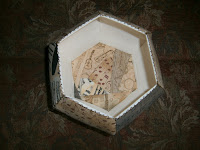As a break from painting my bed base, I painted some Bondaweb. This is the only make I know (is Steam-a-seam the same?), that is glue, with a paper backing that you can draw your shapes/pictures/applique design on. So, much along the same lines as 'teaching your Grandmother to suck eggs', this is how I used it.
If you are a normal person, Bondaweb is bonded (who'da thought!) onto the wrong side of a piece of fabric, rough (glue) side down, with a hot iron. The design is drawn onto the paper side and cut out on the line. The paper backing is then removed and the bonded fabric is placed onto the right side background fabric and ironed in place. But, why use it in it's intended way how about using it a little differently? After all, we left 'normal' fading away into the sunset some time ago and we will not be told how to use something! Icknield Theresa demonstrated this technique at a meeting that she took, at which she spoke so inspirationally about a variety of her work. I think this idea has been around many years though (but then, haven't we all?).
I bought this kit in the Pound Shop (I may sue, as nothing is a pound, 99p, £1.19........) and the Bondaweb was found in a bag from several(?) years back.
This was inside:-
I used the washing detergent cap as a water dispenser, to pour about a teaspoon of water into the mixing tray. I then added less than an inch of each of the acrylic paints into their respective tray. Using the thickest brush, I mixed the water and paint and then splodge them randomly along the rough side of the unfold piece of Bondaweb. This was all the paint I needed to cover the whole piece of Bondaweb. (What am I going to do with the left over paint?) It took about 5 minutes and I took absolutely no care where each colour went and how many of them mixed together. I have to say I was amazed at the outcome, as I have the artistic talent of a blind monkey.
I let it dry overnight, giving me time to insist that all and sundry come and admire it. The wrinkles textures develop because of the extra water mixed in the paint.
When everyone else is sick to death of you talking about the painting you agonised absolutely hours over, it's time to iron it onto your fabric. Use a hot iron again, but keep it moving. Iron from the paper side thoroughly, easing out as many wrinkles as possible (I didn't bother), and then iron again from the back of the fabric side, again thoroughly. Let it cool completely and remove the paper, slowly and carefully
This is the end result:-
 |
| This is the surviving piece of fabric, I lost the paper painted piece that I'd taken to show a friend at Baldock Services |
I'm not sure how to use this yet, but probably as a whole piece - a note book cover? It looks to me like planets, though, so you could draw and cut out circles from the piece while it still has it's paper on. Then, remove the paper and apply to a background fabric. Or it could be rock strata, which could be (gently!) torn from the papered piece and applied.































